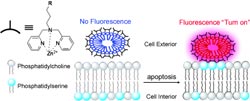Dying Brightly

<br>
Programmed cell death, or apoptosis, occurs tens of millions of times every day in every human body. Researchers in South Korea have devised an easy method to detect apoptotic cells by fluorescence, as they report in Chemistry—An Asian Journal.
Their method makes it easier to detect improper biological regulation of apoptosis, which can lead to neurodegenerative diseases, autoimmune diseases, and cancer.
Apoptosis is involved in macroscopic developmental processes as well. For example, in an embryo, the cells between fingers die by apoptosis to form individual digits, and the tail of a tadpole is resorbed by apoptosis when it metamorphoses into a frog.
Upon apoptosis, the relative composition of the outside and inside of the cell membrane changes, and one component, phosphatidylserine (PS), migrates from the interior to the exterior. Kyo Han Ahn and collaborators at Pohang University of Science and Technology designed an artificial membrane vesicle that fluoresces when it interacts with PS. This so-called liposome is held together by a polydiacetylene backbone and is decorated with zinc atoms at its periphery.
The zinc atoms interact with PS but not with other components of the cell membrane. This interaction distorts the shape of the backbone, causing fluorescence of the liposome. The “turn on” effect eliminates washing steps to remove extra fluorescent marker, making the method easy to use. The selectivity of the interaction means that only apoptotic cells are marked fluorescently. Microscopy images show that the fluorescence is localized on the cell surface, confirming the mode of interaction between liposome and PS.
About the Author
Kyo Han Ahn is professor of chemistry at the Pohang University of Science and Technology (POSTECH; South Korea) and director of the Center for Electro-Photo Behaviors in Advanced Molecular Systems there. His research interests include molecular recognition and sensing, nanometer sized biological functional materials, and luminescent materials.
Author: Kyo Han Ahn, Pohang University of Science and Technology (Rep. Korea), http://www.postech.ac.kr/chem/mras/index.html
Title: Turn-On Fluorescence Detection of Apoptotic Cells Using a Zinc(II)-Dipicolylamine-Functionalized Poly(diacetylene) Liposome
Chemistry – An Asian Journal, Permalink to the article: http://dx.doi.org/10.1002/asia.201201139
Media Contact
All latest news from the category: Life Sciences and Chemistry
Articles and reports from the Life Sciences and chemistry area deal with applied and basic research into modern biology, chemistry and human medicine.
Valuable information can be found on a range of life sciences fields including bacteriology, biochemistry, bionics, bioinformatics, biophysics, biotechnology, genetics, geobotany, human biology, marine biology, microbiology, molecular biology, cellular biology, zoology, bioinorganic chemistry, microchemistry and environmental chemistry.
Newest articles

A universal framework for spatial biology
SpatialData is a freely accessible tool to unify and integrate data from different omics technologies accounting for spatial information, which can provide holistic insights into health and disease. Biological processes…

How complex biological processes arise
A $20 million grant from the U.S. National Science Foundation (NSF) will support the establishment and operation of the National Synthesis Center for Emergence in the Molecular and Cellular Sciences (NCEMS) at…

Airborne single-photon lidar system achieves high-resolution 3D imaging
Compact, low-power system opens doors for photon-efficient drone and satellite-based environmental monitoring and mapping. Researchers have developed a compact and lightweight single-photon airborne lidar system that can acquire high-resolution 3D…





















